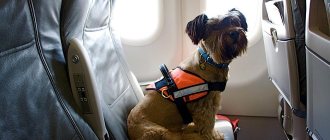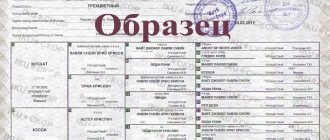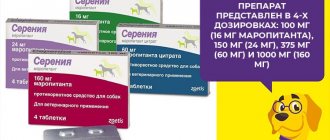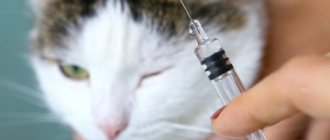What is an international veterinary passport?
A veterinary passport is the main document for a pet. It contains data about the owner and his pet, information about veterinary treatments. The minimum required information is information about rabies vaccinations. The veterinarian fills out all fields.
An international passport may look different
For your information! A distinctive feature of an international passport compared to an internal document is the repetition of information in English.
The document is needed for pets going on a trip. Based on it, other certificates necessary for crossing the border are issued, including a veterinary certificate in Form No. 1. It is issued in state-licensed veterinary clinics one month after the rabies vaccination.
Important! Certificate FNo. 1 is valid for 5 days.
Also, some countries additionally require a certificate with a translation of vaccination information into the official language of the destination.
Why do you need a veterinary passport?
It is required for:
- reminders about the timing of the next vaccination;
- traveling around Russia or to other countries (according to an international document, the veterinary government service issues a certificate for traveling abroad);
- overexposure of a pet in a hotel for animals (health and vaccination records indicate that it can safely live next to neighboring guests).
Why do you need a veterinary passport for a dog?
Passport for a cat: how to make a cat veterinary document
Before you go traveling to the Republic of Belarus or another country with a pet, you need to study the requirements for the import and export of pets. Rules may vary from country to country. You can track changes using specially created services. You can also find other useful information there, such as a list of hotels that allow pets, a list of veterinary clinics, etc.
Note! Metrics and passport are 2 different documents. The second is filled in based on the data from the first. The veterinary passport contains a photo of the animal and verifies its identity. Vaccination dates and other data are checked using the veterinary passport. Therefore, when visiting the clinic, it is recommended to take the document with you.
You need to put a photo of your pet in your passport.
If the veterinary passport for dogs is lost
In case of unexpected loss of your passport due to certain circumstances, you can easily restore it. To obtain this opportunity, the owner should contact the organization that last vaccinated the dog. The clinic provides all the necessary information about the vaccination procedure, as well as where it was carried out.
Visitor requests are recorded in a special journal, so if necessary, you can create an archive of all patient requests. This measure makes it possible to control patient visits, and also allows you to store data on various procedures for a long time.
In addition, all institutions are required to keep such records, since today the legislature obliges veterinary clinics to submit a report on their activities for a certain period. Such documents are stored for ten years.
In the modern world, the owners of their pets prefer the microchipping system and for good reason, because it is this function that allows you to save important information and information about the furry patient, in addition, if your passport is lost, it can be quickly restored.
When issuing documents and certificates in clinics that indicate permission to transport an animal and participate in various exhibitions, carefully check all the details and information provided. Be sure to pay attention to this process, since very often owners miss any important components in the issued document.
Is it necessary to obtain passports for animals?
Passports for dogs, cats and exotic animals are issued at your own request. There are no mandatory requirements for obtaining this document in Russian legislation.
Fighting dogs: types of breeds, list, which is the strongest
A veterinary passport for a hunting dog must be presented at veterinary control when visiting other countries (including Belarus and Ukraine) or regions of the Russian Federation. Also, a dog passport will be useful for show animals to participate in competitions. In addition, a veterinary passport helps you track medical information.
Important! It is issued after primary vaccination or antiparasitic treatment. The document is usually filled out by a doctor at a veterinary clinic.
Place of receipt and registration rules
How to remove a tick from a dog at home
The passport is issued by a veterinarian at a state clinic. A blank form can be purchased locally and immediately given to a specialist to fill out the information. It is better to check on the spot how much this service will cost.
Sample of a blank international passport
Typically, a veterinary passport is obtained when the puppy is first vaccinated. After the procedure, a record of vaccination is added to the document. Therefore, most often the breeder receives a passport.
New passports are more convenient to use. In addition to information about medical treatments, they provide additional fields for notes and repetition of section names in international English.
Note! Any entry must be certified by the signature of a veterinarian and the seal of the medical institution, otherwise the data will not be included when passing control at the border. The seal of the kennel club is not enough to confirm the information.
What information about the dog must be indicated in the document?
Nowhere is it stipulated what specific information should be included in the document and how to fill out a veterinary passport for a dog. But there are standard forms that usually include the following fields:
- details of the animal owner (full name, address, telephone number);
- information about the pet (photo, age, breed, color, special features, number, date and place of installation of the chip);
- information about vaccinations, medical treatments, operations;
- information about offspring.
Data on vaccinations contain the names and series of vaccines and drugs administered, their expiration dates and dates of vaccination. When specifying information about microchipping, it is more convenient to use a special sticker with the chip number rather than filling out the information manually.
The electronic chip, located inside a small capsule, is injected subcutaneously into the withers area using a disposable syringe. The size of the chip is very small, so the procedure does not cause pain in the dog, and the chip itself does not cause problems for the animal in the future. The chip code cannot be changed; it can be used to identify an animal in any country. The information is read using a special device.
For your information! In many countries, vaccinations and medical treatments performed only after the chip has been installed are taken into account. All interventions that were performed previously are not taken into account.
All sections of the passport are filled out with a blue or black pen in two languages - Russian and English.
Type of animal in the passport: example
To freely leave the country with your pet, you must fill out the document correctly.
The “Breed” section is filled out according to the information from the animal’s card or metric received from the nursery (breeder). For example, outbred animals are recorded as half-breed (mixed breed).
Gender of the dog in the passport: how to indicate
In some sections, it is enough to enter one character. The “Gender / Sex” field is filled in as follows:
- male - male (M);
- female - female (F).
Information about vaccination and deworming
This is the most important section of the veterinary passport. It must be filled out in as much detail as possible, because records of vaccinations and other medical interventions are paid attention to even when transporting a pet across the country. Some countries attach importance to certification of the administered vaccine. Therefore, it is advisable that the vaccination record be accompanied by a special sticker with the number and other information about the vaccine.
Information on vaccinations is certified by the signature of a veterinarian and the seal of a medical institution
Basic vaccines and procedures, information about which is included in the section:
- rabies test. This is especially true for dogs that are taken hunting with them. Not required for domestic travel. But entering some countries with a dog, cat or ferret is impossible without this research. The test is done in laboratories that have passed state accreditation. The study is carried out one month after vaccination. The result is valid for 3 months;
- operations (including sterilization). The date and name of the doctor who performed the procedure is recorded;
- deworming, tick and flea treatment. The date of the procedure, the name of the medicine, and the dosage of the medicine are indicated. Additionally, a sticker is attached to the drug label. When processing it independently, the owner can enter information into the passport himself. In this case, you must contact the clinic so that the veterinarian examines the pet and certifies the record with a seal and signature;
- vaccination. The date of vaccination, the name and number of the vaccine, and the sticker from the label of the ampoule with the drug are recorded.
For your information! For females who have given birth, the dates of estrus, mating and birth, and the number of babies born are also indicated.
What does the type of dog in the passport mean? Veterinary passport for cats
Today I want to talk about such a useful thing as a veterinary passport or an international vaccination certificate. In this article we will dwell in more detail on how to fill out a veterinary passport for dogs and cats. Our website already has an article about what a veterinary passport is, you can read it.
How to choose a veterinary passport?
Depending on what kind of animal you have, purchase the appropriate passport. The passports themselves are universal; they can be created for cats, dogs and other animals. There are passports for cats and dogs, most of them are international, in such a passport the columns are duplicated in English, I came across passports where English and Finnish were present. In any case, the difference between an international veterinary passport is that it has a translation into English; with such a passport, your pet will easily pass veterinary control in any country in the world.
Where can I get a veterinary passport?
Veterinary passports (forms) are freely sold in pet stores and veterinary pharmacies, clinics and offices. In addition, a passport is issued either by the breeder when you buy a kitten or puppy, or it will be given to you by a veterinarian after he gives it to your pet.
How to fill out a veterinary passport correctly.
Fill out the veterinary passport
dogs or cats is not at all difficult. Most of the entries are made by a veterinarian; the owner fills out only a few fields.
Pets photo
I think everything is clear here. You can take a photo of your cat or dog and paste the resulting photo into your passport; no stamps are required, and filling out this field is at the request of the owner.
Description of the animal / Main information
Pets name
Filled out in accordance with the card or metric received from the breeder/kennel, if the animal is purebred, if not - arbitrarily.
Breed
Here, too, we indicate the breed as in the metric; for “ordinary” cats and dogs we write the word “Mestis”.
Date of birth
We indicate the exact date if there is a metric; if not, we write an approximate one.
Gender in animals is written as male and female, not male and female. You can indicate the gender as “cat”, “cat”, “male” and “bitch”, but the latter looks like a curse word, so it’s better to be a female or you can draw “shield and spear of Mars” or “mirror of Venus”, for those who have artistic abilities.
Color
Either we write off the metrics or think for ourselves. For white and black animals everything is simple, we write “white” or “black”. There are also more complex options, for example, “tortoiseshell” or “black and tan”; here the easiest way is to look on the Internet for photographs of the colors of six cats and dogs and their names, then select the one you want and write it down in your passport.
Distinguishing marks
Usually these are some color features, for example, a white spot behind the ear, “socks” on the front legs. In this field, describe your pet's distinctive feature, if any.
Animal card number
Pedigree number
We take these numbers from the document received from the breeder or nursery; if not, we leave empty fields.
Tatoo (tag) number
This applies more to dogs, if puppies get a tattoo with the number of the kennel, this number is an identifier, and it is indicated in the passport. Recently, the stigma has become less and less common; instead, dogs and cats are microchipped.
This is where the owner completes filling out data about the animal, such fields as
Identification number
Information about animal registration / Pets Registration
To be completed by a veterinarian.
Information about the pet owner is also filled in independently. There is nothing complicated, we write the last name, first name and patronymic, address and telephone number.
Breeder
The fields are filled in by the breeder; if not, leave them blank.
All other fields will be filled out by the veterinarian.
If we are talking about a purebred puppy, the owner does not have to think about how to get a passport for the dog: the breeder transfers the baby to a new family along with a full package of documents. But what if the veterinary passport becomes unusable and gets lost? Or was the dog adopted from the street? After all, regardless of the breed, breeding value and other secondary factors, the dog must have a veterinary passport.
Traveling on public transport, transporting a dog by personal vehicle, attending public celebrations, exhibitions, sporting competitions, participating in breeding - if the owner does not care about how to obtain a passport for the dog, all this will become inaccessible to his pet. A veterinary passport does more than just prove a dog’s identity. This is a document that proves that the pet has been vaccinated against viral infections that are dangerous to other animals and people.
A veterinary passport for a hunting dog is required to register the pet in the hunting license. If documents for a hunting dog are not properly completed, the owner will be accused of poaching, fines will be applied to him, and he may even not be allowed to register in the future.
As soon as a kitten appears in the house, it is necessary to start preparing a veterinary passport, which will include all the data about the animal, information about vaccinations given, diseases suffered and preventive measures taken. From our article you will learn how to make a veterinary passport for a cat of simple and international standards.
Many pet owners think that a veterinary passport is only necessary if they are planning to travel abroad with their pet. This assumption is wrong.
A veterinary passport is a document with which you can identify a cat and its owner, find out the history of diseases suffered by the animal, and become familiar with the peculiarities of vaccination.
As experts in the field of felinology note, a cat needs a passport for statistics. Based on passport data, a special veterinary service keeps statistics on the number of pets living in a certain locality. In addition, a veterinary passport must be provided not only when crossing the border, but also within the home state or even city. People traveling in the same minibus or tram may inquire about whether the animal is vaccinated against rabies and other life-threatening diseases.
Video “Why does a cat need a veterinary passport”
From this video you will learn why a cat needs a veterinary passport.
Obtaining a regular passport
According to the opinions of experienced breeders and veterinarians, every pet should have a special document - a passport. Let's figure out how you can get documents for a cat.
What you will need
A regular or internal pet passport can be issued at any veterinary clinic.
In Russia, this document does not have a specific, established
Actions to take if an animal's veterinary passport is lost
If the document is lost, it will have to be reissued. To do this, you need to contact the place where the lost document was issued. If the animal has been microchipped, restoring the information will not take much time. It is enough to read the data using a special device.
Microchipping a dog
Important! If it is impossible to restore the data, you will have to vaccinate your pet again, conduct an examination, and try on sizes.
A veterinary passport for a dog is the main document that gives the right to transport a pet across the border. Even if the animal gets lost in a foreign country, a passport will help prove the rights to the dog.










